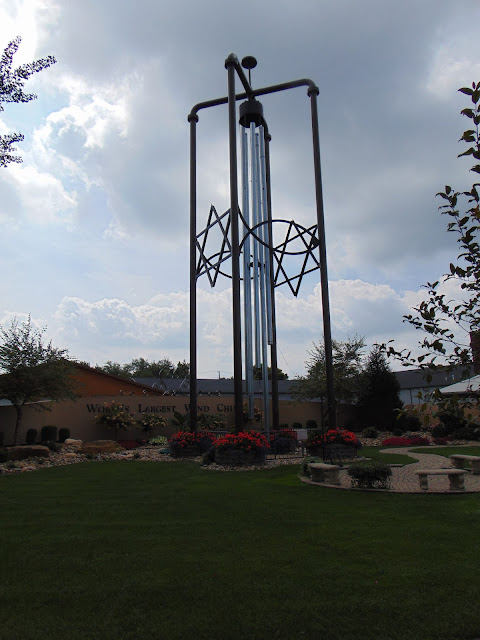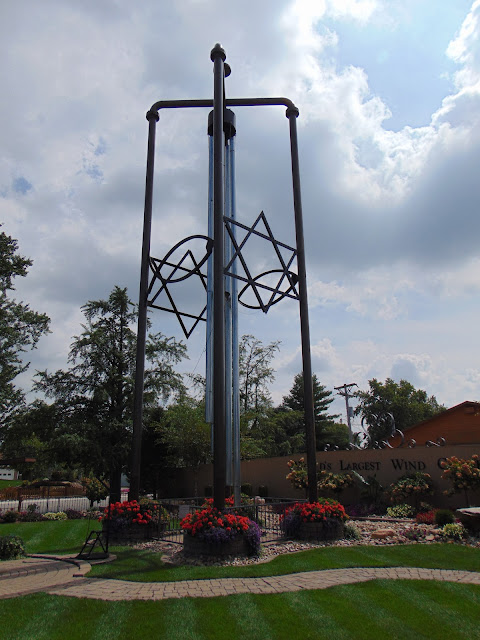About halfway between St. Louis, Missouri and Indianapolis, Indiana along I-70 is the small town of Casey, Illinois, or rather, a small town with a lot of big things, such as the World's Largest Windchime and the World's Largest Rocking Chair. But while Casey is a nice place fit for a giant, the town had more humble beginnings, stemming back to the days of the historic National Road. Casey's beginnings can be found in a settlement named Cumberland, situated along the historic National Road in eastern Illinois. A post office named after
Zadok Casey (who once represented Illinois in the United States Congress) was established at Cumberland in 1838, but was discontinued nine years later. As a result, Cumberland is now part of the city of Casey.
The original town of Casey was first platted in 1851 and surveyed in 1853. Casey grew up as a farming community in the 19th Century, with 2 railroads serving the area, the Pennsylvania Railroad and the Doty Railroad. Casey was one of many towns along the National Road that grew thanks to the oil boom of the early 20th Century. By 1907, around 2,000 oil wells had been drilled in the immediate Casey area and today, over 1 million barrels of crude oil is pumped each year in Clark County, Illinois alone. Casey’s Fairview Park was a spinoff of these prosperous years and at one time featured a racetrack. Visitors to Casey will also observe a sign acknowledging native son, David Hanners, a 1989 Pulitzer Prize winning reporter. The
USA Softball of Illinois Hall of Fame Museum is also in Casey. So where do the big things come into the story of Casey, Illinois?
In 2011 a man from Casey by the name of Jim Bolin wanted to give back and had a vision to try to drive economic development and put Casey back on the map, especially given that I-70 is nearby. The idea was to create big things and the people will come. So the concept of "Big Things Small Town" was born, with the help of Jim Bolin and his business,
Bolin Enterprises. In 2011 the World's Largest Wind Chime was introduced. From that point, there are now nine Guinness book of World Records items in Casey, which include the World's Largest Golf Tee, World's Largest Knitting Needles and Crochet Hook, World's Largest Mail Box, World's Largest Rocking Chair, World's Largest Wooden Shoes, World's Largest Pitch Fork, and soon to be World’s Largest Gavel. Along with that, there are several big things around Casey, that are not world records, but add to the scenery and mystique of what the town has to offer. Things like a large pencil, a large birdcage and a large yardstick, which is much longer than a yard. Plus there are more big things that get added to the collection in Casey.
Most of the materials used to create the big things are recycled. Almost all of the wood used comes from old telephone poles. As for the metal that is used, much of it is damaged pipe and out of use oil tanks. You could say that having a stash of junk has been quite an asset for these projects. Most of the big things are located around downtown Casey, making it a perfect place to stretch your legs after a long drive on I-70. There are also a few big things that are located on the outskirts of town as well. I didn't get to see all the giant attractions while I was in Casey, but I got to see plenty of big things. So let's check one of the more unique and cool collections of roadside oddities out there.
 |
| We'll start our tour with the World's Largest Rocking Chair. Thr chair, which was topped off on August 25, 2015, is 56 feet, 6 inches tall, and weighs 46,200 pounds. It beats the record of the previous largest chair (42 feet, 1 inch tall) in Fanning, Missouri |
 |
| A stand of wayfinding signs points you in the direction of the different World's Largest Things. |
 |
| Probably the tallest cactus in the great state of Illinois. |
 |
| World's Largest Antlers. This is one of the first big things you'll encounter if you are coming into Casey from I-70. |
 |
| The World's Largest Wind Chime. With chimes that are suspended 49 feet above the ground, the massive wind chime stands 55 feet tall. The longest of five chimes is 42 feet long, nearly double that of the previous world record holder. The chimes sing gentle and deep as they strike. |
 |
| A few of the big things are not found during a walk through downtown, so renting a golf cart is an option. |
 |
| The World's Largest Teeter Totter. |
 |
| A giant pencil looms! |
 |
| The World's Largest Mailbox. There is actually a way to get into the mailbox so you can get a bird's eye view of downtown Casey. |
 |
| Speaking of birds, here's a giant birdcage. |
 |
| Just a large ear of corn. |
 |
| This giant yardstick is 36 feet long instead of 36 inches long. As with many of the big things you'll find around Casey, there is a scripture passage that is included. |
 |
| A giant spinning top. |
 |
| A giant mousetrap that looks like it could take on a regular sized human being. |
 |
| Fittingly, the World's Largest Golf Tee is found at the Casey Country Club. Fore! |
 |
| The World's Largest Token Coin is found on IL 49 at the Casey State Bank. |
 |
| And we're back to where we started, at the World's Largest Rocking Chair. |
 |
| Now, let's learn about the early history of Casey, Illinois. |
 |
| The historic National Road once went through present-day Casey on what is now Main Street. |
 |
| Heading back to IL 49 and eventually, back onto I-70. |
How to Get There:
Sources and Links:
Casey Chamber of Commerce -
Big Things / World's Largest Things Map (PDF)
Casey Chamber of Commerce -
Welcome to Casey IllinoisBig Things Small Town -
Casey, IllinoisEnjoy Illinois -
Big Things in a Small TownNational Road Association of Illinois -
Eastern Communities



























Comments